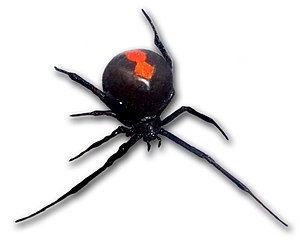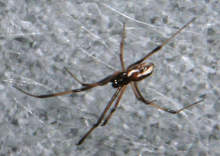Red-backed spider
| Red-backed spider | ||||||||||||
|---|---|---|---|---|---|---|---|---|---|---|---|---|

Red-backed spider, female |
||||||||||||
| Systematics | ||||||||||||
|
||||||||||||
| Scientific name | ||||||||||||
| Latrodectus hasselti | ||||||||||||
| Thorell , 1870 |
The Redback ( Latrodectus hasselti ) is originally in Australia -based Orb Weaver Spider (orb spider). It belongs to the genus of the real widows . The specific epithet hasselti in the scientific name honors the Dutch toxicologist Alexander Willem Michiel van Hasselt (1814–1902).
description
The female reaches a body length of 10 to 12 mm, the males are significantly smaller with 3 to 4 mm. The body color of the female animals is black with a conspicuous red, sometimes interrupted stripe on the upper side of the round abdomen ( opisthosoma ). On the underside they have a drawing consisting of two merged triangles, similar to an hourglass . Juvenile animals also have white spots. In the males, the overlying stripe is often less pronounced. Their bodies are light brown with white spots on the top of their abdomen. The hourglass-like stripe on the bottom is paler.
Occurrence
The red-backed spider is native to Australia. However, through international trade, it was also introduced as a neozoon on other continents . It is also found imported in Southeast Asia and New Zealand . The species was introduced in Japan in 1995. Despite intensive fighting, it was able to establish itself in Kansai , near the city of Osaka .
Specimens of the red-backed spider have also been introduced into Belgium and Denmark, but they were unable to spread because of their small number and probably also because of the climatic conditions.
Way of life
Red-backed spiders usually feed on insects, but animals such as small lizards that get caught in the web can also be prey. Females also steal prey from other spiders' webs.
The female uses an amino acid derivative as a pheromone to attract males. It can store sperm and thus fertilize eggs over a period of two years. About 50 to 300 eggs are spun into a cocoon . The cannibal young animals hatch after two to four weeks. Ten egg cocoons with up to 2500 young animals can be produced in the laboratory in 16 weeks. In New Zealand is hybridization of L. hasselti with L. Katipo possible.
Sexual, post-copulatory cannibalism can be observed in this species. The males position their abdomen by means of a " copulation salto" over the jaws of the females. 65 percent of the males are injured during mating, 12.5 percent die after the first copulation . Males that survive the first mating and mate with the female a second time can release their sperm into both seed pockets and thus reproduce more successfully.
The male's participation in cannibalism through the sacrificial somersault has advantages in terms of reproduction and the transmission of his own genes : cannibalized males mate longer and fertilize twice as many eggs. Females who have eaten their partner during copulation are less likely to re-mate with subsequent males.
Bite accidents and toxicity
The species is not aggressive . The males are non-toxic, only the females are dangerous for humans. The bite itself can hardly be felt, the characteristic abdominal pain that follows is described as "unbearable". The main component of the poison, alpha-latrotoxin , causes cramps and pain. The symptoms last for about twelve hours and then go away. There is a mortal danger if the respiratory center is affected by the symptoms of paralysis.
Since records began in Australia, only 13 proven fatal bites have occurred with L. hasselti, while it is estimated that 5,000 to 10,000 bites have occurred with all species of the genus Latrodectus on the continent. Red-backed spider bites are the leading cause of Antivenom administration in Australia (300 to 400 times a year).
Individual evidence
- ↑ a b MAF BIOSECURITY PEST RISK ASSESSMENT: Spiders Associated With Table Grapes From United States of America (State of California), Australia, Mexico and Chile Text, PDF, at www.biosecurity.govt.nz ( Memento of the original from May 23 2010 in the Internet Archive ) Info: The archive link was inserted automatically and has not yet been checked. Please check the original and archive link according to the instructions and then remove this notice. (accessed February 14, 2010)
- ↑ a b Peter Jäger: Latrodectus mactans introduced into Germany Arachnol. Mitt. 37: 35-38 Text, PDF, at www.senckenberg.de (accessed on February 14, 2010)
- ↑ Redback-Spider on the website of the Australian Museum (accessed on February 14, 2010)
- ↑ Elena Jerhot, Jeffrey A. Stoltz a. a .: Acylated serine derivatives: a unique class of arthropod pheromones from the Australian red-backed spider Latrodectus hasselti. In: Angewandte Chemie. 122, 2010, p. 2081, doi : 10.1002 / anie.200906312 .
- ↑ Stefan H. Nessler: Sexual cannibalism. Terms and definitions. In: stefan-nessler.de, accessed on February 17, 2010. ( Memento from October 21, 2010 in the Internet Archive )
- ↑ Maydianne CB Andrade, Lei Gu, Jeffrey A. Stoltz: Novel male trait prolongs survival in suicidal mating. In: Biology Letters. 1, 2005, p. 276, doi : 10.1098 / rsbl.2005.0318 .
- ↑ Kenwyn Blake Suttle: The Evolution of Sexual Cannibalism Article at ib.berkeley.edu (English, accessed on March 22, 2010)
- ↑ Tobias Dörr: Latrodectus spec. or the black widow article at www.fsbio-hannover.de (accessed on February 14, 2010)
- ↑ Derek S. Wheeler, Hector R. Wong, Thomas P. Shanley: Pediatric critical care medicine: basic science and clinical evidence Springer 2007: p. 1699. Reading sample from books.google.de (English, accessed on February 27, 2010)
Web links
Red-backed spider in the World Spider Catalog
- Fact Sheet Redback spider at Commonwealth Scientific and Industrial Research Organization (accessed February 14, 2010)

